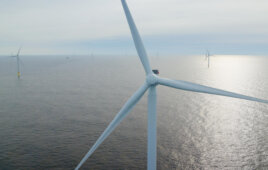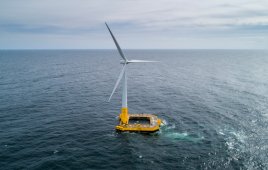Completion helps demonstrate the feasibility of semi-submersible foundation concept for floating offshore wind turbines.
ABS, a leading provider of classification and technical services to the offshore and marine industries, has completed the design review of the Front End Engineering and Design (FEED) documentation for the VolturnUS, a floating offshore wind turbine (FOWT), developed by the University of Maine Advanced Structures and Composites Center.
“UMaine is pleased that its innovative design became the first floating wind turbine concrete semi-submersible hull to be reviewed by ABS, and found to meet the ABS requirements,” said Dr. Habib J. Dagher, P.E, UMaine Composites Center executive director and principal investigator.

The patented VolturnUS, developed by the UMaine Advanced Structures and Composites Center is based on a concrete four-column semi-submersible hull concept.
“After 10 years of development, this is a major milestone for our program, and we expect the VolturnUS hull concept to continue to attract private investment from the U.S. and around the world. Nearly 70 percent of the U.S. offshore wind resources can be captured using the UMaine VolturnUS technology, and we are looking forward to working with offshore wind developers across the U.S.”
In 2013, the UMaine team successfully tested the feasibility of the concept by developing a 1:8 scale model and deploying it in Castine, Maine. Maine Aqua Ventus I, GP, LLC, is now leading a full-scale, two turbine demonstration project called New England Aqua Ventus I, a 12 megawatt (MW) floating offshore wind pilot project to develop a clean, renewable energy source off Maine’s shores. This pilot project will demonstrate the innovative VolturnUS at full-scale as a viable and economical alternative for offshore wind developments in water depths greater than 50 meters.
“ABS has been the leading classification organization for the offshore industry from the very beginning of offshore operations, and we are pleased that the renewable energy industry is now looking to ABS for FOWT design review,” said ABS Executive Vice President for Global Offshore Ken Richardson.
“ABS was the first classification organization to work offshore and continues to be a pioneer in setting standards for safety and excellence.” Anthony Viselli, University of Maine engineering manager, said ABS worked closely with the university through all design phases of the Aqua Ventus project. “We are excited about the positive results from the design review and the potential for deploying this technology elsewhere in the U.S. and abroad,” he said.
ABS completed a design review of the semisubmersible, verifying compliance with the ABS Guide for Building and Classing Floating Offshore Wind Turbine Installations. The process consisted of an independent review of the hull/tower structure, coupled aeroelastic/hydrodynamic loads, safety, stability, electrical systems, equipment, piping and hydrodynamic and station keeping design. ABS determined that FEED design, as presented, met the requirements of the relevant ABS Rules and regulatory standards.
Filed Under: News, Offshore wind




